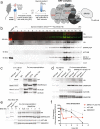Rescue of deficits by Brwd1 copy number restoration in the Ts65Dn mouse model of Down syndrome
- PMID: 36289231
- PMCID: PMC9606253
- DOI: 10.1038/s41467-022-34200-0
Rescue of deficits by Brwd1 copy number restoration in the Ts65Dn mouse model of Down syndrome
Abstract
With an incidence of ~1 in 800 births, Down syndrome (DS) is the most common chromosomal condition linked to intellectual disability worldwide. While the genetic basis of DS has been identified as a triplication of chromosome 21 (HSA21), the genes encoded from HSA21 that directly contribute to cognitive deficits remain incompletely understood. Here, we found that the HSA21-encoded chromatin effector, BRWD1, was upregulated in neurons derived from iPS cells from an individual with Down syndrome and brain of trisomic mice. We showed that selective copy number restoration of Brwd1 in trisomic animals rescued deficits in hippocampal LTP, cognition and gene expression. We demonstrated that Brwd1 tightly binds the BAF chromatin remodeling complex, and that increased Brwd1 expression promotes BAF genomic mistargeting. Importantly, Brwd1 renormalization rescued aberrant BAF localization, along with associated changes in chromatin accessibility and gene expression. These findings establish BRWD1 as a key epigenomic mediator of normal neurodevelopment and an important contributor to DS-related phenotypes.
© 2022. The Author(s).
Conflict of interest statement
The authors declare no competing interests.
Figures




References
-
- Antonarakis SE, Lyle R, Dermitzakis ET, Reymond A, Deutsch S. Chromosome 21 and down syndrome: from genomics to pathophysiology. Nat. Rev. Genet. 2004;5:725–738. - PubMed
-
- Lejeune J, Turpin R, Gautier M. [Mongolism; a chromosomal disease (trisomy)] Bull. Acad. Natl Med. 1959;143:256–265. - PubMed
-
- Bull MJ. Down syndrome. N. Engl. J. Med. 2020;382:2344–2352. - PubMed
Publication types
MeSH terms
Substances
Grants and funding
- F99 NS118735/NS/NINDS NIH HHS/United States
- R01 DA040621/DA/NIDA NIH HHS/United States
- R37 NS046789/NS/NINDS NIH HHS/United States
- R01 HD097088/HD/NICHD NIH HHS/United States
- F31 MH116588/MH/NIMH NIH HHS/United States
- S10 OD026880/OD/NIH HHS/United States
- R01 NS085171/NS/NINDS NIH HHS/United States
- SC2 GM122646/GM/NIGMS NIH HHS/United States
- F99 NS125774/NS/NINDS NIH HHS/United States
- R01 HD082568/HD/NICHD NIH HHS/United States
- R15 HD090603/HD/NICHD NIH HHS/United States
- R01 MH111604/MH/NIMH NIH HHS/United States
- R01 CA163915/CA/NCI NIH HHS/United States
- S10 OD030463/OD/NIH HHS/United States
LinkOut - more resources
Full Text Sources
Medical
Molecular Biology Databases

